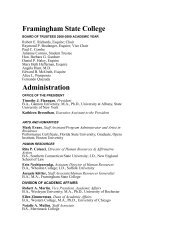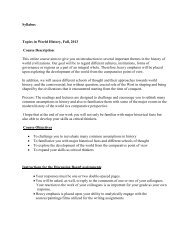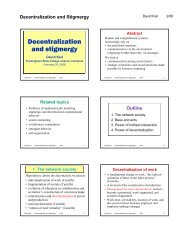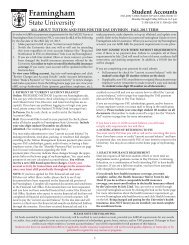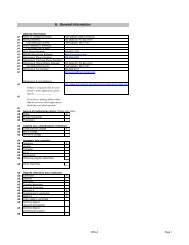Abstracts 2011 - Framingham State University
Abstracts 2011 - Framingham State University
Abstracts 2011 - Framingham State University
You also want an ePaper? Increase the reach of your titles
YUMPU automatically turns print PDFs into web optimized ePapers that Google loves.
Krysten Dufort<br />
Parasitism of imported Green Tree<br />
Pythons (Morelia viridis) and Scrub<br />
Pythons (Morelia amethistina).<br />
Millions of wild-caught reptiles are traded in the exotic pet trade every year. The<br />
majority of these reptiles come from Indonesia and Malaysia, and among these reptiles<br />
the most commonly traded snake genera are Cobras (Naja) and Pythons (Python).<br />
Many of these reptiles are parasitized, as they come from tropical areas with high<br />
parasite abundance. In the wild, reptiles often demonstrate a balanced host-parasite<br />
relationship, where the parasite thrives with little to no effects on the hosts’ fitness and<br />
health. However, when reptiles are brought into captivity, the extra stress suppresses<br />
the reptile’s immune system, making them more susceptible to the negative effects of<br />
parasitism. The purpose of this study was to gain an understanding of the parasites<br />
found in wild-caught Green Tree Pythons (Morelia viridis) and Scrub Pythons (Morelia<br />
amethistina) imported from Indonesia. Twenty snakes were dissected and their organs<br />
were examined for parasites. Fifty percent of the snakes examined were parasitized<br />
with a mean parasite load of 7.4 parasites per snake. A total of 74 parasites were<br />
found, all of which were nematodes found in the digestive tract of the snakes. There<br />
was no significant difference (p=0.09) in the mean number of parasites found in male<br />
and female Green Tree Pythons, however the female parasite load was 7 times higher<br />
than the males. Positive allometry was observed between snout-vent-length (SVL)<br />
and number of parasites (mass exponent = 1.8). Females were significantly longer<br />
than males (p=0.007), possibly explaining the higher parasite loads in female Green<br />
Tree Pythons. The older the host, the greater the intensity of infection, and because<br />
snakes exhibit indeterminate growth, larger snakes were expected to have higher<br />
parasite loads. Overall, this study provided a better understanding of the types of<br />
parasites found in Green Tree Pythons as well as the locations where they are<br />
commonly found.<br />
Green Tree Python Scrub Python<br />
http://commons.wikimedia.org/wiki/File:Green_Tree_Python.jpg<br />
# of parasites<br />
100<br />
10<br />
# of parasites in Green Tree Pythons<br />
increases with snout-vent-length<br />
y = 0.0016x 1.7857<br />
R² = 0.1881<br />
Female<br />
Male<br />
Juvenile<br />
1<br />
10 100 1000<br />
(Allometry: note log scale)<br />
SVL (cm)






